According to the Guinness Book of World Records, the Bible is the best-selling book of all time. Between five and seven billion copies have been distributed over the last 1,500 years. And today Bibles are printed at a pace of 80 million copies a year. So, what does the Bible have to say about animals? A lot, as it turns out.
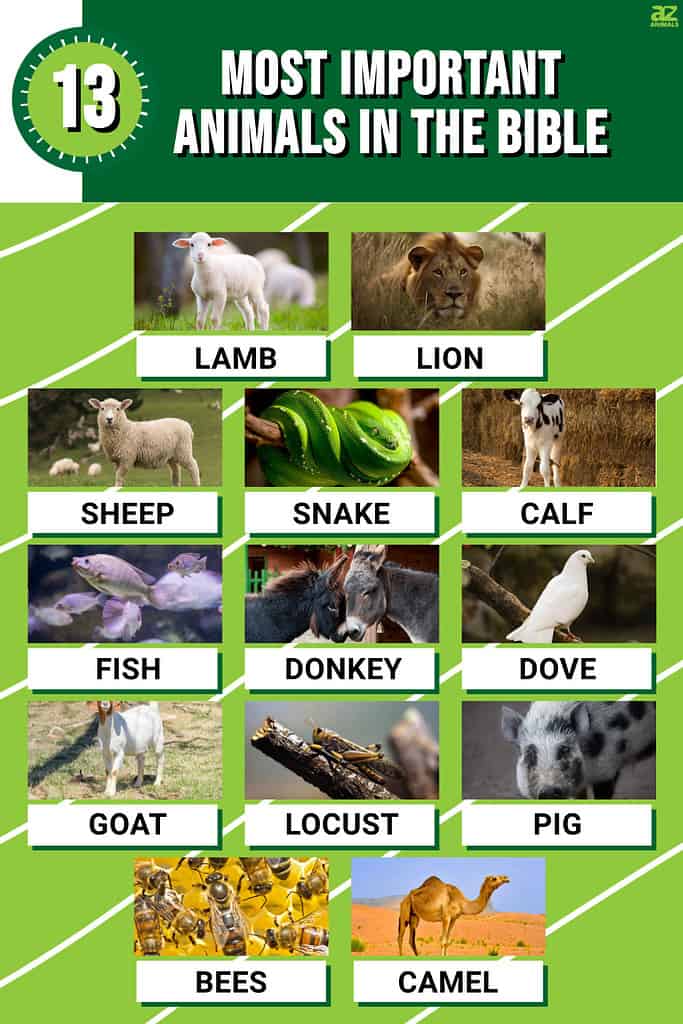
The creation story, Noah’s Ark, dietary and sacrificial laws, allegories, and prophetic symbolism are all concerned with animals. Animals are an essential part of the Bible’s message, just as they are essential to our life on Earth. We made a list of the 13 most important animals in the Bible. For each, we give you a few examples of stories and symbolism in the Bible, as interpreted by many Christians. Hopefully, this helps you understand a little more of what you’ll find in this all-time bestselling book.
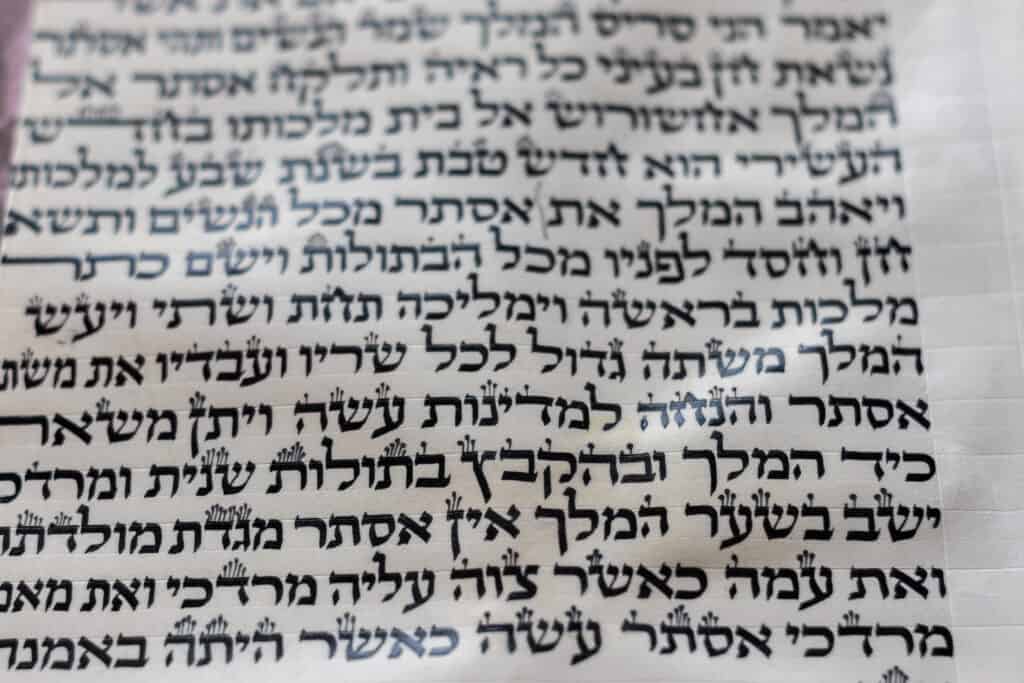
The Christian Bible is divided into the Old Testament, written mainly in Hebrew, and the New Testament, written mainly in Greek.
©yosefus/Shutterstock.com
1. Lamb
In the Middle East, lambs were, and are an important food source. The meat is more tender than a full-grown sheep. At a time when there was no refrigeration, it was the right size for one meal. At the same time, their deaths are poignant because they are so docile, gentle, and trusting. They don’t complain even when facing slaughter. Killing such creatures seems at best a necessary evil.
Lambs are a symbol of purity and innocence. This is precisely why they were animal sacrifices and part of the Passover meal (Exodus 12:3-11). They symbolized something that was without sin taking away the punishment of others’ sins. In this sense, the lamb became one of the main animal symbols used by Christians to represent Jesus. The Bible calls him the “Lamb of God, who takes away the sin of the world” (John 1:29). And it pictures him at the end of the world as a lamb. He stands alive and well on God’s throne (Revelation 5:6). So, the humble and longsuffering lamb turns out to be the most honored and powerful animal symbol in the Bible.
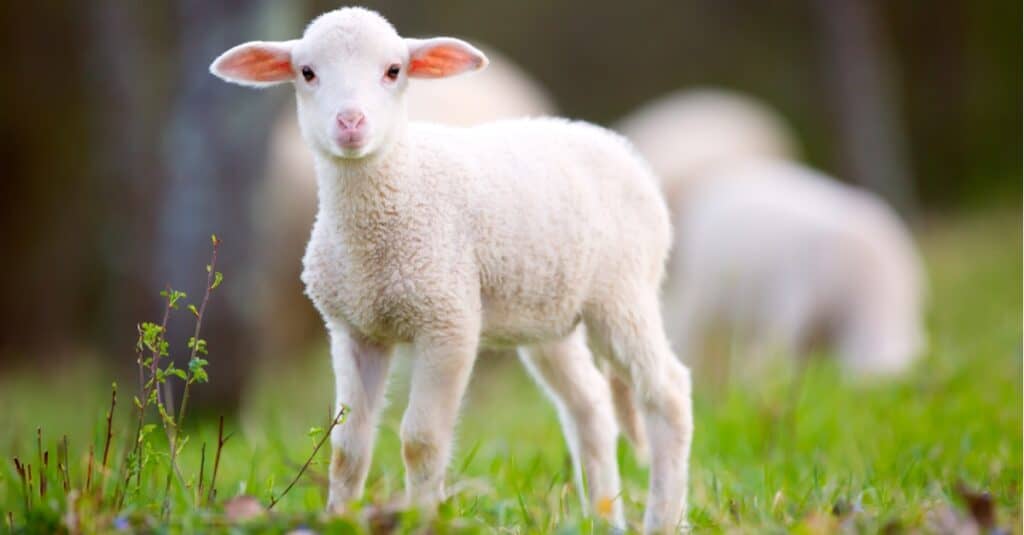
Lambs are a symbol of innocence. They were used in the Passover sacrifice and as a symbol for Jesus, the “Lamb of God.”
©iStock.com/Filip_Krstic
2. Lion
The second most commonly used symbol for Jesus in the Bible is the lion. In ancient times, lions were indigenous to the entire Middle East and North Africa. But today they reside only in sub-Saharan Africa. Israel’s King David was a shepherd as a young boy. He had to kill lions and bears that tried to prey on his flocks (I Samuel 17:34-37). The prophet Daniel fell out of favor with the Persian king and landed in a den of lions. Miraculously, they didn’t hurt him, and officials released him. They threw his accusers to the lions in his place. The lions immediately devoured him (Daniel 6).
Fans of the C.S. Lewis book The Lion, the Witch, and the Wardrobe might realize that the heroic Aslan the lion represents Jesus. Lewis chose this symbol because, after the lamb, the lion is the second most important animal figure that represents Jesus. The lion was symbolic of the Israelite tribe of Judah. Jesus was a member of this tribe and a descendant of the kings of Israel.
In Revelation 5:5, he is the victorious “lion of the tribe of Judah.” But surprisingly, the Bible also uses the lion as a symbol of Satan. He “prowls around like a roaring lion looking for someone to devour” (1 Peter 5:8). Altogether, the lion is both a symbol of regal ruling power and a violent, voracious predator. These two sides to the animal’s behavior explain how it can be such radically different figures in the Bible.

Jesus was called the “Lion of Judah,” but the Bible also compares Satan to a roaring, voracious lion.
©keith hudson/Shutterstock.com
3. Sheep
Unlike the lamb, a symbol of innocence, sacrifice, and ultimately Christ himself, sheep as a whole are symbolic of the people of God. In ancient times as today, sheep herding was an important part of survival in a mountainous and desert climate with unreliable rainfall. Sheep feel lost and alone if they are not part of a herd, but they will follow that herd even if it is leading them into danger. Without a shepherd to show them where water and good pasture are and defend them from predators, they cannot survive long on their own. Sheep and other livestock were also an important measure of wealth for tribal chieftains – a source of pride for their owners despite the trouble they can get themselves into. All of these are parallels to our behavior and the value and care of God.
Moses and David
Moses and David both had earlier experiences protecting flocks of sheep before becoming “shepherds” leading the Israelite people. Shepherds outside of Bethlehem were among the first to hear the good news of the Messiah’s birth, announced to them by a flock of angels (Luke 2:8-15). During his ministry, Jesus felt compassion for the crowds of people who came to him and seemed like “sheep without a shepherd” (Matthew 25:31-34). He described himself as the “good shepherd” who lays down his life for the sheep (John 10:14-16).
To encourage even the most lost and sinful people to come back to God, he used an example of a shepherd who would leave a flock of 99 sheep in a field to go look for the one missing sheep until he found it and joyfully brought it home (Luke 15:3-7). Finally, the Bible says that at the end of the world, Jesus will divide the people of Earth into the “sheep” on his right and the “goats” on his left (Matthew 35:31-32), symbolic of those who are eternally saved or lost.

God’s people are symbolized as a herd of sheep in the Bible. Jesus called himself the “Good Shepherd.”
©Jesus Keller/Shutterstock.com
4. Snake
The snake is one of the first animals mentioned in the Bible. It’s described as the craftiest of all the animals. Apparently possessed by the devil, a snake in the creation story has the ability to talk. It tempts the first man and woman to eat the forbidden fruit, resulting in them coming under God’s curse and being thrown out of Paradise. The snake’s curse was to crawl on its belly, “eat dust,” and be at odds with humanity in the future – a battle that a descendant of humans would one-day win (Genesis 3).
Throughout most of the Bible, snakes continue to play the villain role. During the Israelites’ escape from slavery in Egypt, Moses does a miracle of turning his staff into a living snake. Later, a large number of Israelites came across vipers in the wilderness. Many of them receive bites. Moses makes a bronze snake on a pole that they can look at and miraculously heal (Numbers 21:4-9). While gathering firewood on the island of Malta, a venomous snake bit the apostle Paul, but he shook it off into the fire and suffered no ill effects (Acts 28:1-6).
The devil himself is called an “ancient serpent” in Revelation 2:20. Snakes do get at least one positive mention though. Bible prophecy predicts God’s curse will one day lift from the world and symbolizes this with the image of animals leaving peacefully together, including this shocking prediction: “The infant will play near the cobra’s den, and the young child will put its hand into the viper’s nest” (Isaiah 11:8).
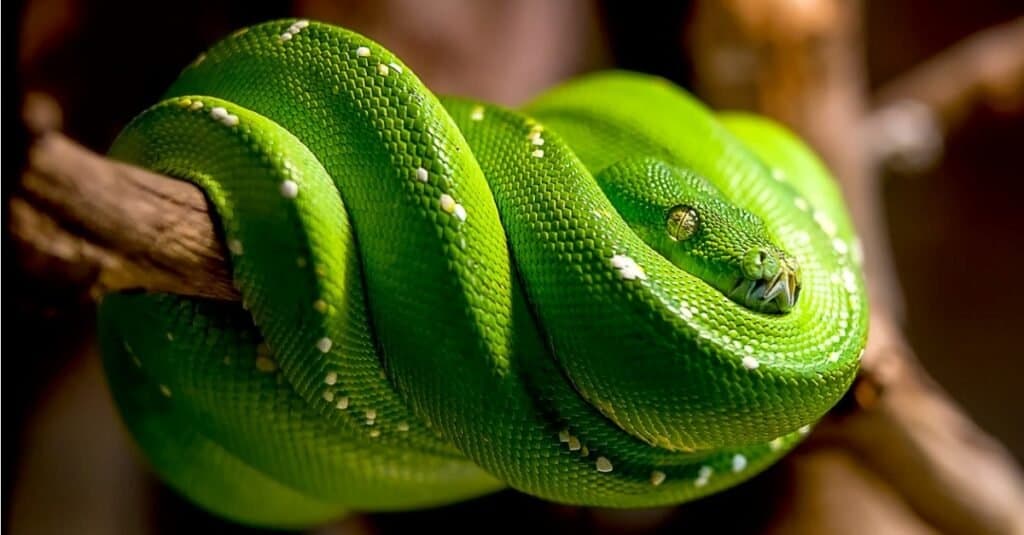
The Bible describes the snake as the “craftiest” animal. In the Creation story, the snake tempts the first man and woman to disobey God.
©iStock.com/timspix58
5. Calf
Ancient Egyptians worshiped a sky goddess named Hathor in the form of a cow, and her son Apis as a young bull. Apis was connected with ideas of dying and being reborn and was seen as a mediator between humans and the gods. The Bible tells how the Israelites were in captivity in Egypt for 400 years and escaped into the desert under the leadership of Moses. While Moses was receiving instructions from God on Mount Sinai, the Israelites became impatient and made an idol to worship in the form of a golden calf, something they would have been familiar with in Egypt (Exodus 32:1-6). Later, after a civil war divided Israel into two separate kingdoms, the northern kingdom started a separate religion that involved worshiping golden calves at two locations.
In the New Testament, one significant place we see the calf is in the story of the Prodigal Son. Jesus tells about a rebellious son who leaves his father’s house and wastes his inheritance. Later, broke and starving, he returns home hoping for only the status of a slave and food to eat. Instead, his father joyfully restores him to an honored position as his son and orders that the “fattened calf” that was being saved for a special occasion would be slaughtered for a feast in his son’s honor. Jesus told this story as an illustration of how God gladly welcomes home those who have wandered far away from him.
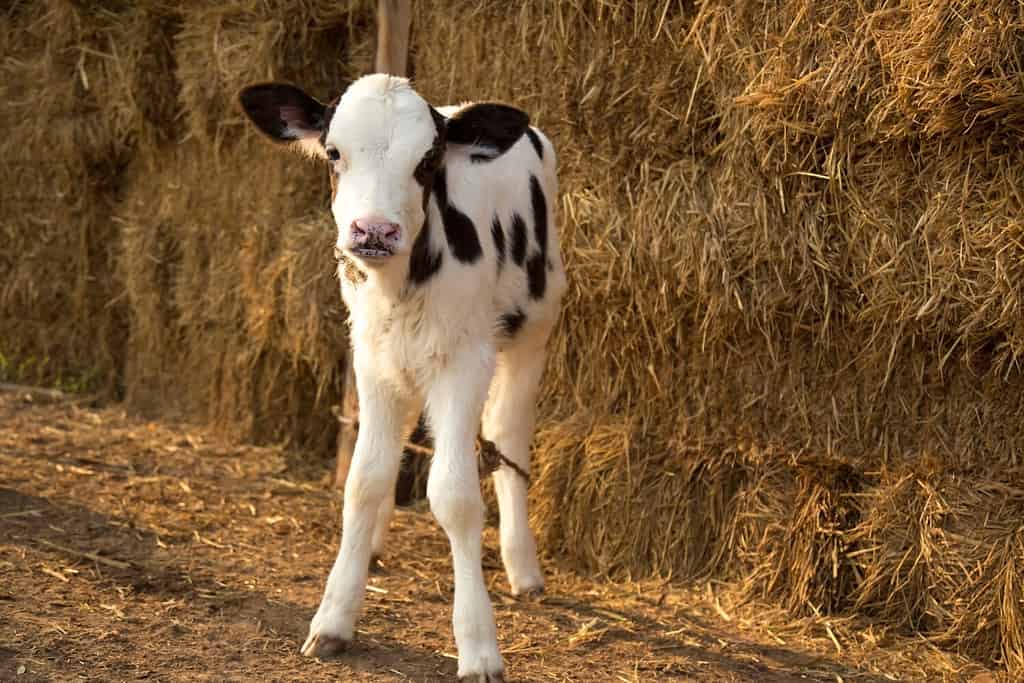
Calves in the Bible are mainly associated with idol worship. Captivity in Egypt exposed the Israelites to this practice.
©Napaphat Kaewsanchai/Shutterstock.com
6. Fish
Much of the Bible takes place in what is today Israel and Palestine. Although this “Holy Land” is located on the Mediterranean Sea, most of the action of the Bible takes place on land and on the inland freshwater Sea of Galilee. An exception to this is the famous story of Jonah and the Whale. Jonah was a prophet who fled from an unpleasant assignment from God on a ship headed west across the Mediterranean Sea. During a storm, he was thrown overboard and swallowed by a big fish (the Bible does not specify that it was a whale, though that would seem most likely), then spat up on the shore of Israel again. This is all described in the biblical book of Jonah.
An isolated pod of sperm whales does live in the Mediterranean to this day. Incidentally, there are at least three documented modern cases of humans surviving being swallowed by a whale. For the details on those stories, and how to survive if it happens to you, check out the video below.
Tilapia
Besides the fish/whale story of Jonah, the regular-sized fish figure very prominently in the life story of Jesus because he grew up in the region of Galilee in northern Israel. One of the main species there is tilapia, a fish that is popular today for its tasty, mild flavor. The first disciples Jesus selected were fishermen named Peter, Andrew, James, and John. Part of his appeal to them was his promise to use them to “fish for people” (in other words, to make disciples) (Matthew 4:19).
Jesus did several miracles with fish, such as multiplying five loaves of bread and two fish to feed 5,000 people (John 6:8-11), giving his disciples a miraculous catch of fish that almost sank their boats (Luke 5:1-11), and providing a coin in the mouth of a fish Peter caught to pay their taxes (Matthew 17:24-27). For men who had struggled their whole lives to support their family from the fickle sea, seeing the power of Jesus to provide in these ways made them eager to understand who he was and how to be part of the movement he was starting.
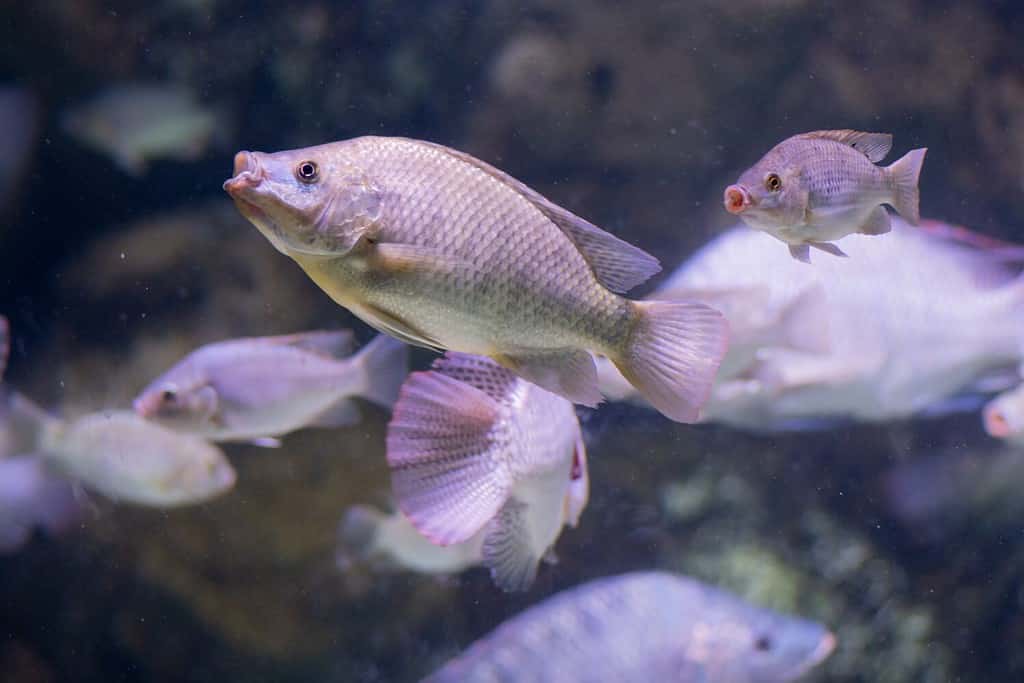
The blue tilapia (
Oreochromis aureus), is a fish in the family Cichlidae. Native to Northern and Western Africa, and the Middle East
©SingerGM/Shutterstock.com
7. Donkey
Like the snake, the donkey is reported in the Bible to have spoken in human language, though only one time as far as we know. A prophet named Balaam was on his way to see the migrating crowd of Israel coming into the land after their escape from Egypt, having been offered money to pronounce a curse on them. According to Numbers 22:21-34, the donkey he was riding repeatedly refused to go forward, turned aside from the road, and finally lay down on the road. Balaam began to beat the animal until God empowered it to speak to him to ask why he was beating it. Then Balaam looked up and realized an angel with a sword was blocking the road, previously visible only to the donkey (Numbers 22:21-34). This is an interesting story for animal lovers who might wonder sometimes what an animal would say if it could talk.
In Bible times, donkeys were used to pull carts with heavy loads and could be ridden as well. Popular legend has it that Mary rode a donkey to Bethlehem while she was pregnant with Jesus. To fulfill a prophecy, and in a display of humility, Jesus rode a donkey followed by its colt into Jerusalem. He was greeted like a king by the people, only to be rejected and crucified a week later. It does go to show that animals can often be much more loyal friends than people are (although that is not the main point of the story).

A donkey was a humble mode of transportation and a longsuffering beast of burden for the common people in ancient Israel.
©iStock.com/miskokordic
8. Dove
Doves are always depicted in a positive way in the Bible. In the story of Noah’s Ark, the world is flooded and only the family of Noah and breeding pairs of animals are preserved in a large boat. Similar flood stories are told by ancient cultures all over the world, suggesting to some researchers there must be a historical core to this story from an event in the early history of humanity. As the floodwaters recede, Noah releases a series of birds to see what they will discover. A dove returns with an olive twig in its beak – a hopeful symbol of a new and restored Earth (Genesis 8:8-12). This is the origin of the popular “dove of peace” and “olive branch” symbols used in peace movements and international organizations.
Shortly after Jesus was born, his parents made an offering of two doves on his behalf in the temple of Jerusalem (Luke 2:21-24). This was a “poor man’s” offering for families who could not afford a lamb. This is in keeping with Jesus being born into humble circumstances and living a life of poverty that helped him identify with the struggles of poverty-stricken people.
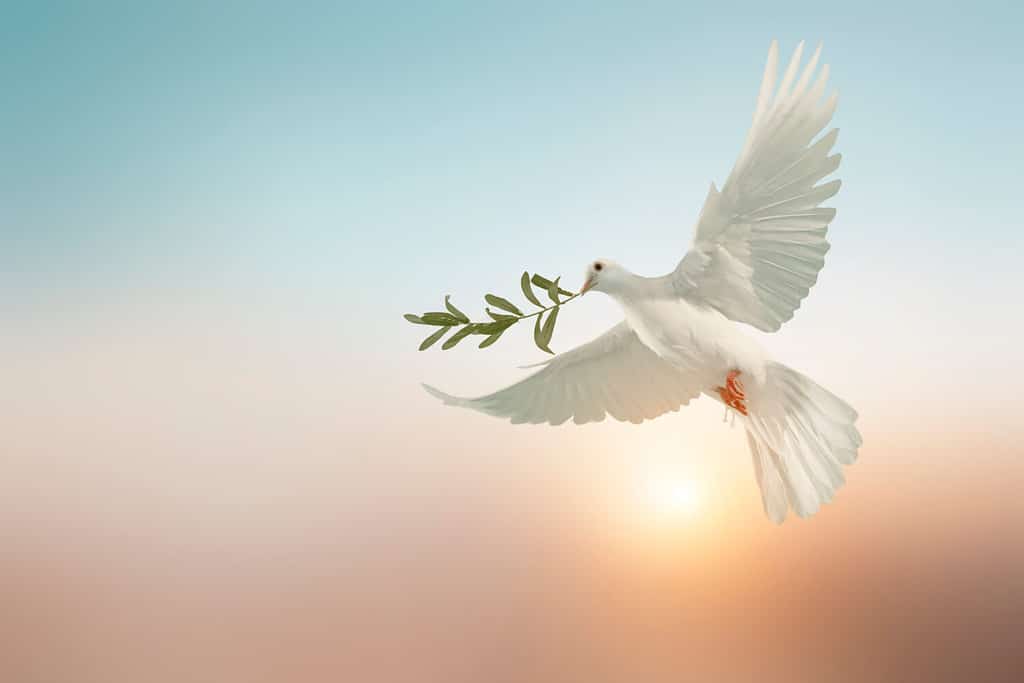
A dove bringing an olive branch is a common symbol of peace that originates in the Bible story of Noah’s flood.
©LittlePerfectStock/Shutterstock.com
Holy Spirit
The most important symbolism of the dove though is its identification with the Holy Spirit. Christianity has a complex view of God as a “trinity.” In this view, there is just one God, but this God exists as three “persons” simultaneously. All of these are equal to one another, and equally divine:
- The Father: God as creator, provider, lawgiver
- The Son (Jesus): God as savior, shepherd, and sacrifice
- The Holy Spirit: God living in people as a counselor and source of power
At the beginning of his adult ministry, Jesus was baptized in the Jordan River as a symbol of his submission to God. John the Baptist, who baptized him, reported seeing a vision of the Spirit of God descending on him “as a dove” (John 1:32-34). It’s not clear whether this means the Spirit literally looked like a dove, or just moved in a similar way or speed and landed gently like a dove. Either way, the dove is a frequently seen symbol of the Spirit of God in Christian art and is a popular image in Christian merchandise and church logos today. No doubt, the gentleness of the dove makes this an appealing image for something as mysterious and potentially terrifying as a divine supernatural being.
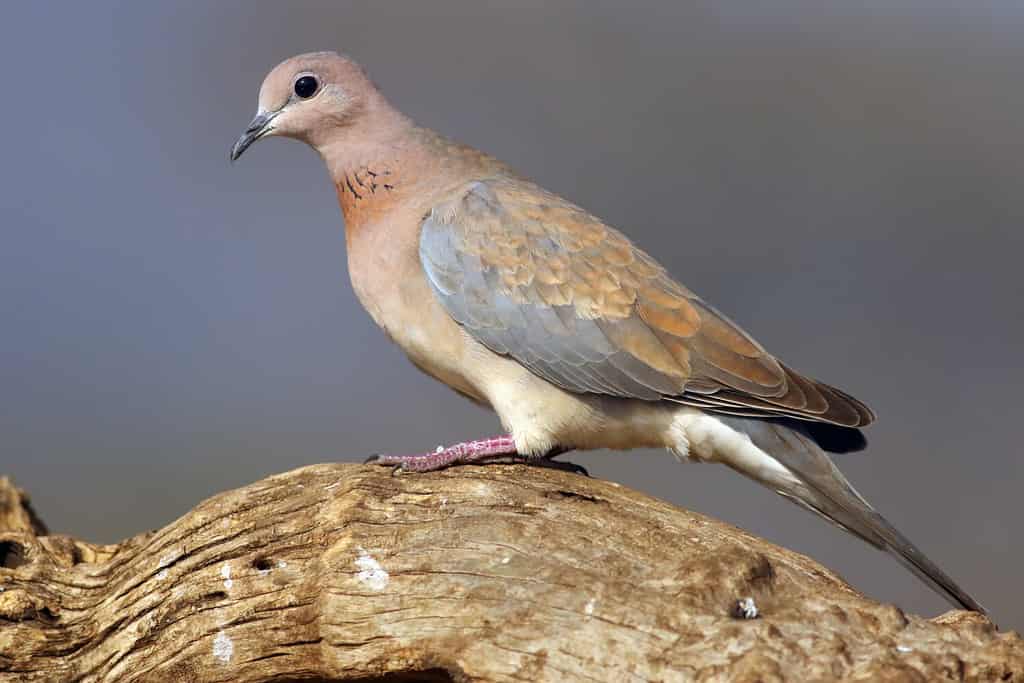
The most common dove in the Middle East and North Africa is called the laughing dove.
©Karel Bartik/Shutterstock.com
9. Goat
Goats are similar to sheep, but they have horns and they’re much more temperamental. They are also much more destructive to the natural environment, literally eating almost anything. Maybe these kinds of characteristics are why goats became associated with rebellion and evil. For example, ancient Israelites had a practice of choosing a goat as a “scapegoat,” symbolically transferring their sins to it, then releasing it into the wilderness, most likely to be killed by predators (Leviticus 16:20-22). This represented rejecting sin and sending it away from the community.
As already mentioned, Jesus said he would judge each human being at the end of the world, separating them into sheep (saved people) on his right and goats (lost people) on his left (Matthew 25:32-33). Although the Bible does not describe Satan as looking like a goat and doesn’t have any verses comparing him to a goat, these associations of the goat with evil in the Bible have led modern Satanists to depict him in their art as having a goat’s head and hooves on a man’s body.

Compared to sheep, goats can be very stubborn, rebellious, and destructive. They are used in the Bible as a symbol of sin and lost people.
©BearFotos/Shutterstock.com
10. Locust
Throughout history, the Middle East has been plagued with periodic infestations of migrating locusts, flying insects similar to grasshoppers. In small numbers, they’re not a problem, and can even be a nutritious food source. The prophet John the Baptist lived in the wilderness and subsisted on locusts and wild honey. However, periodically locusts multiply in tremendous numbers and settle on the landscape, eating every green thing in sight before moving on to another area. Locust infestations can result in mass starvation in hard-hit areas.
The Bible reports that the Israelite people were in slavery in Egypt. The pharaoh was unwilling to let the people leave the country, even when their leader, Moses, did repeated miracles and called down plagues on the country, such as infestations of flies, frogs, gnats, and locusts (Exodus 10:3-6). Ultimately, only the death of every firstborn person in Egypt was enough to make Pharaoh relent. One of the unsettling predictions of the book of Revelation is a plague of stinging locusts with a strange appearance that will inflict misery on people before the world ends (Revelation 9:1-11). Most of the book of Revelation is highly symbolic and Christians are not agreed on how to interpret some of these symbols.

Migratory locusts like this can multiply into huge swarms and destroy crops in a large area.
©Vladimir Wrangel/Shutterstock.com
11. Pig
Under the Old Testament law, animals were divided into categories of “clean” and “unclean.” Jewish people today refer to clean animals and foods as “kosher.” Pigs were most definitely in the “unclean” category. Pork and pork products are still today forbidden food for both Jews and Muslims. Pigs are highly intelligent, but they can also be quite aggressive and deliver painful bites and lacerations with their tusks to other livestock and to people. They are indiscriminate omnivores and so they pick up a lot of diseases from food sources in various states of spoilage and decay. They root around in the ground for grubs and tubers to eat and like to wallow in water by ponds and rivers to cool off, which contaminates the water for fish and other animals.
The Bible usually depicts pigs in the context of a person who lives a self-indulgent, sinful lifestyle. This person has no concern for the consequences. In the story of the Prodigal Son, the degradation of the young man is seen in his job feeding pigs. He was so hungry he wanted to eat their slop (Luke 15:11-16). Jesus also warned, “Do not throw your pearls to pigs.” This perhaps referred to not wasting time on people who are unwilling to listen (Matthew 7:6).
Most dramatically, the Bible describes an incident when Jesus did an exorcism. This act caused a group of demons to leave a possessed man. They infested a herd of 2,000 pigs instead, who reacted by stampeding into the sea and drowning. A wonderful day for the possessed man but a sad and symbolic ending for the cursed pigs.

12. Bees
Bees are not a huge part of the Bible but the honey they work so hard to produce is. In ancient times, honey was the most easily available sweetener. Yet, people could not gather it without the risk of a sting. And it was not abundant. It may have been a little more of a treat for poor people. An undisturbed honeycomb was a rare treat. God promised the Israelites a promised land “flowing with milk and honey” (Exodus 3:8). The prophet John the Baptist subsisted “off the grid” in the desert on locusts and wild honey (Matthew 3:4).
Honey didn’t work out so well for Samson. He was a leader of the Israelite people. God gave him tremendous strength to fight against the Philistines, the mortal enemies of his country. However, to keep that strength, Samson had to obey dietary rules strictly. He faced a test one day when he found a bees’ nest in the rotting carcass of a dead lion. Without hesitation, he scooped out some honey and ate it. He did this, despite it having been in contact with an “unclean” animal (Judges 14:8-9). This was one of several examples that illustrated his disregard for God’s law. He did these things despite all that God was doing for his success.

Honey was a highly valued treat in Bible times. It was one of the only sweeteners available to them.
©iStock.com/Inventori
13. Camel
Camels are important beasts of burden for crossing dry, sandy, desert environments. They were especially important to long-distance trade in North Africa and the Arabian Peninsula. Their feet keep them moving steadily on loose sand. At the same time, they are notoriously stubborn and bad-tempered. In the Bible, they don’t really have a symbolic significance, but owning a large number of camels was a sign of wealth.
Job was an Old Testament character who was immensely wealthy but also righteous. God allows all he has to be taken from him as a test of his faith, including a large herd of camels. In the end, Job passes the test and receives even more than what he lost. His camels are specifically mentioned in Job 1:3, 17, and Job 42:12. The heroine of another camel story is Rebekah, a young girl. She shows kindness to travelers by drawing water manually from a well to water their camels. This was a tremendous amount of work, considering that a thirsty camel can gulp down gallons in minutes! By doing this, Rebekah set off a chain of events that would see her marry Isaac, the son of Abraham. She went on to become one of the mothers of the Israelite nation (Genesis 24:12-22).
What Jesus Said
Finally, Jesus used a camel in a very memorable figure of speech. A rich young man came to him asking how he could be part of God’s kingdom forever. Knowing that his wealth was his biggest obstacle, Jesus told him to sell everything, give the money to the poor, and become his disciple. The man left, saddened by this answer.
Jesus said to his disciples, “It is easier for a camel to go through the eye of a needle than for someone who is rich to enter the kingdom of God” (Matthew 19:24). Some say the “eye of a needle” was a low city gate that camels had to kneel to get through. These images conjure a picture of an awkward animal, overloaded with wealth, trying to force itself through a small opening. The camel needs to shed its burdens, just as the rich young man needed to shed his wealth and possessions. The disciples said this would be impossible, to which Jesus replied, “With God all things are possible” (Matthew 19:26).

Loaded with valuables, it was hard for camels to get through doorways. Jesus used it to symbolize how wealth interferes with spiritual progress.
©Wolfgang Zwanzger/Shutterstock.com
Are Animals Good or Bad?
These are highlights of some of the most important animals in the Bible. We hope you enjoyed the stories and symbols associated with them. You’ll notice that some of them are depicted quite negatively. Others are loaded with excessively positive imagery. Does this mean that the Bible teaches that there are “good” and “bad” animals? No, that’s not the case. Some animals were “clean” or “unclean.” But this was not because there is anything inherently evil about them. It is to make distinctions in foods. This reminded the people that they were different, holy, and set apart to serve God in the world.
Importantly, we should also mention that Christians believe these distinctions between clean and unclean animals were lifted by God after the death and resurrection of Jesus (Acts 10:9-16). This is why Christians eat pork and other foods. For concerned animal lovers, the biblical view is that all animals are “good,” and part of a “very good” creation (Genesis 1:20-24). And certainly, regardless of religious beliefs, we can agree that our wonderful natural world is very good, indeed!
Summary of the 13 Most Important Animals in the Bible
| Rank | Animal |
|---|---|
| 1 | Lamb |
| 2 | Lion |
| 3 | Sheep |
| 4 | Snake |
| 5 | Calf |
| 6 | Fish |
| 7 | Donkey |
| 8 | Dove |
| 9 | Goat |
| 10 | Locust |
| 11 | Pig |
| 12 | Bees |
| 13 | Camel |
The photo featured at the top of this post is © iStock.com/NoonVirachada
Thank you for reading! Have some feedback for us? Contact the AZ Animals editorial team.






